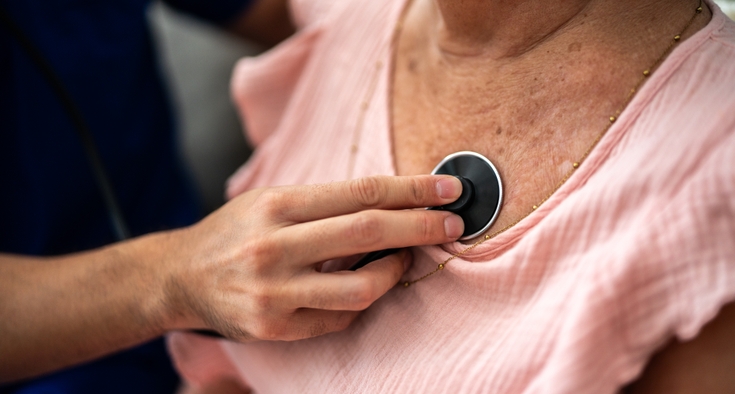You’re probably familiar with hypertension.
Perhaps you’re even being treated for it. Nearly half of American adults – about 120 million people – have the condition also known as high blood pressure, according to the Centers for Disease Control and Prevention (CDC).
Hypertension is usually defined as blood pressure above 140/90. It often has no symptoms, which is why it’s sometimes called the “silent killer.” If left untreated, it can cause heart disease and stroke.

Cardiologist Dr. Lisa Rose-Jones recently joined Novant Health Heart & Vascular Institute - Wilmington Main. She’s a specialist in treating another, lesser-known hypertension – pulmonary hypertension – that specifically affects the lungs’ blood vessels.
In one form of pulmonary hypertension – pulmonary arterial hypertension, or PAH – blood vessels in the lungs are narrowed, blocked or otherwise destroyed. The damage slows blood flow through the lungs and increases blood pressure in the lung’s arteries. The heart then must work harder to pump blood through the lungs, and the extra effort eventually causes the heart to weaken.
Rose-Jones is board-certified in internal medicine, cardiovascular disease and advanced heart failure and transplant. She’s now working with pulmonary arterial hypertension patients to create customized treatment plans, provide comprehensive care and help them thrive. Here she answers FAQs about pulmonary hypertension, how it’s diagnosed and how it’s treated.
Exceptional cardiovascular care.
7 things you should know about pulmonary hypertension
What is pulmonary hypertension, and how is it different from “regular” hypertension?
Pulmonary hypertension is a catch-all term for elevated blood pressure specific to the arteries in the lungs. Estimates indicate it could affect 1 in 100 people, which works out to 50 million to 70 million people. It’s more common among older adults.
Potential complications that may result from pulmonary hypertension include right heart failure symptoms like lower extremity swelling or fluid collecting in the abdomen. Passing out is associated with more advanced disease.
What causes pulmonary hypertension?
There are quite a few causes.
Pulmonary hypertension can develop on its own or be caused by another disease or condition, such as congenital heart disease or having taken the diet pill fen-phen. Some of the most common causes are lung disease – COPD, for instance – and left-sided heart disease, which affects the part of the heart that pumps oxygen-rich blood to the body.
Pulmonary arterial hypertension, or true thickening of the lung arteries, can be associated with other diseases like scleroderma or other connective tissue diseases, lupus, liver disease or can even be hereditary.
Best doctors. Amazing nurses. Remarkable care.
Can it be prevented?
Patients often wonder about that. And the answer is: Not always.
Some risk factors are beyond your control. But there are steps everyone can take to help lower the risk, and they include getting regular exercise, following a heart-healthy diet and not smoking or using tobacco.
What are the symptoms of pulmonary hypertension?
Shortness of breath during normal activities, such as walking up the stairs, is the most common.
Others are lightheadedness; a fast pulse; fatigue; swelling in the ankles, legs and belly; and chest pain. But they can be subtle. Breathlessness – the most common symptom – is shared with lots of conditions.
Sometimes – just as with “regular” hypertension – there are no symptoms. And even if there are only mild symptoms in the beginning, they worsen over time.
How is pulmonary hypertension diagnosed?
An echocardiogram (an ultrasound of the heart) is the first step in diagnosing the disease. This uses sound waves to show how your right ventricle is working while measuring blood flow through your heart valves.
A right heart catheterization is required for diagnosis. This measures the pressure inside your pulmonary arteries and gauges how much blood your heart can pump per minute.
A right heart catheterization is an outpatient test that typically takes about 30 minutes. This shows us real-time data about how elevated the pressures are in the lungs and how the heart is pumping. This way we can customize treatment and recommendations. To do the test, I insert a thin, flexible tube into a blood vessel (vein) in the neck, groin or arm. Next, I thread it through the right side of the heart into the pulmonary artery so I can measure the blood pressure and oxygen level in the heart and lungs.
I’m looking for PAH – the thickening or narrowing of vessels in the lungs I’ve mentioned. It’s a condition that responds very well to pulmonary vasodilator medication.
We also have tests – blood tests, scans and X-rays – that can help determine the underlying cause of the condition.
What’s the treatment?
PAH can be treated directly, while, with other types of pulmonary hypertension, we have to treat the root cause.
Diuretics, calcium channel blockers and oxygen therapy can all be used to treat PAH. In addition, pulmonary vasodilators are medications that help your pulmonary arteries relax, which has the effect of lowering blood pressure and easing the stress on your heart’s right side.
There’s no cure, but treatments can help patients live longer, healthier lives. And it’s crucial to get diagnosed and treated because untreated pulmonary hypertension can be fatal.
If untreated, pulmonary hypertension forces your heart to work harder to send blood – oxygen-poor blood, at that – to your lungs.
Have there been any recent advancements in pulmonary hypertension diagnosis or treatment that give you hope?
It's such an exciting time in the field of pulmonary hypertension. We have seen an explosion of research with therapeutics in the last decade. We have improved methods of increasing blood flow to the lungs and combination therapies in a single pill to reduce pill burden. A brand-new novel therapeutic approved by the FDA in March, may, we believe, lead to disease regression in the circulatory system of the heart and lungs.










